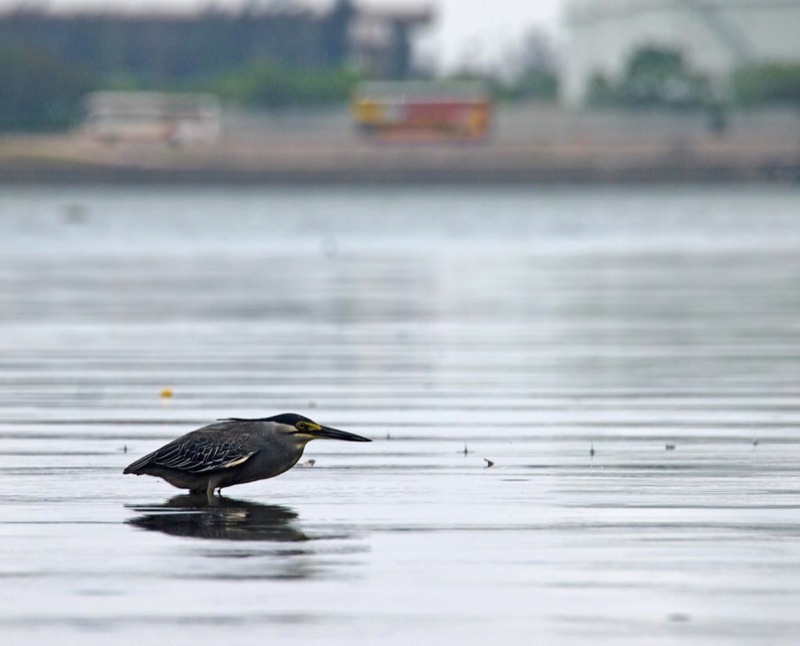Tung Chung Bay, north Lantau, is in an area that has featured in China’s history, and is rich in biodiversity – yet will be devastated by expansion of Tung Chung town. 香港應珍惜東涌灣 [see below]
There’s a wonderful wetland on the north coast of Lantau. It’s a place where you can walk along the tideline, and see wildlife like shellfish and fiddler crabs, each male with a single huge claw for display, a tiny claw for feeding. Mudskippers – air breathing fish – flip themselves across wet mud. Kingfishers and herons are on the lookout for unwary fish and crabs.
The wetland is fringed by mangroves, with trees specially adapted to life in the inter-tidal zone. This is one of Hong Kong’s few sites for horseshoe crabs – “living fossils” that have been on earth for 450 million years, with two of the world’s four horseshoe crab species breeding here.

The wetland, Tung Chung Bay, is in an area that has featured in China’s history. Long before anyone had heard of Hong Kong Island, the last members of the Song dynasty fled to Lantau, pursued by a 200,000-strong Mongol army. They arrived in 1277, two years before the Song army’s final defeat.

Today, the Hau Wong Temple stands by the bay, commemorating a general who bravely tried to protect the Song’s last boy emperors.
Nearby are the remains of a fort dating from 1174–1189, when it was built to combat salt smugglers, and a battery. The infamous pirate Cheung Po-tsai, who is said to have commanded a fleet of up to 600 vessels, was defeated just offshore in a battle with Chinese, British and Macanese ships.
Tung Chung River flows into the estuary, and is rare among Hong Kong rivers for being almost untouched by reservoirs and other schemes. The two main streams cascade down the slopes of Sunset Peak and Lantau Peak, and the river is outstanding for both biodiversity and scenery. There was a public outcry in late 2003, when boulders were removed from the lower river channel for landscaping work at Hong Kong Disneyland, leading to work on restoring the channel.
Yet now, the government plans to destroy most of Tung Chung Bay, lower river channel and nearby areas – for the expansion of Tung Chung. And a look at the map for planned reclamation and new constructions suggests this will be done with all the brute force and “brainpower” of the Incredible Hulk.
The map shows the bay, already reduced by reclamations for an existing housing estate, will be essentially destroyed to make way for more high-rise blocks, which will also spread up the lower river valley. This lovely area will be devastated, gone forever.
The plans date back to original work on the airport at Chek Lap Kok and associated projects. I recall a planners’ vision for Tung Chung as something akin to a mini garden city, which would be a fine place for residents and visitors alike. Yet looking at the Tung Chung that was actually built, it seems to me a soulless town of concrete blocks, where there is little for visitors to do but buy from factory outlets, or get out as fast as possible.


There’s irony in a property development being called Caribbean Coast. Perhaps there’s something Hong Kong style about this – admiring and coveting natural beauty half a world away, whilst building artificial environments and carelessly vandalising the superb wild places that are right on our doorstep.
Tung Chung’s creators made a place that’s both on and yet disconnected from Lantau, which Henry Tang once called “Hong Kong’s biggest and most beautiful island”. Now, instead of trying to integrate with Lantau, plans call for more of the same: more concrete, minimal soul, zero passion; not a place to nurture vibrant communities.
C.Y. Leung, Chief Executive and a founding member of the Countryside Foundation, is among those expressing support for expanding Tung Chung. After years of waiting, it seems there is a sudden urgency for fast tracking the developments and the destruction, never mind what environmental impact assessments might say.

There is little reason for hope, but it is possible to envisage a different future for Tung Chung Bay and Tung Chung River. Visiting recently, I enjoyed walking paths by an old banyan tree, across tidal channels, and to Hau Wong Temple. I envisaged nature and heritage trails for visitors and Tung Chung residents, with facilities and conservation work. These could benefit local people – both bringing some extra income from visitors, but also making Tung Chung a better place to live, and raise families.
Green groups have made similar recommendations, in last bid efforts to protect Tung Chung Bay. In K.S. Wong, we now have an Environment Minister with expertise in green architecture – who could surely oversee more intelligent, more holistic planning for Tung Chung.
What do you think? Even if you live far from Tung Chung (I’m on Cheung Chau), the bay is surely a treasure that belongs to us all – and could belong to future generations. If you are curious, maybe visit the bay, for an enjoyable outing, and then perhaps add your voice for calls to protect Tung Chung Bay and the river.
Written as opinion piece for Ming Pao Weekly; appeared (in Chinese) on 11 August 2012.

香港應珍惜東涌灣
香港應珍惜東涌灣
Martin Williams
大嶼山北岸擁有一片美妙的濕地。你可以在這裡沿著潮汐漲退的路線漫步,欣賞各種野生生物,包括多種介殼類水生動物,例如是招潮蟹。雄性招潮蟹身上長有大小不一的螯:大螯用來展示威勢、小螯用來覓食維生。入水能游、出水能跳的彈塗魚,在濕地之間躍身而過。當然少不了對魚蟹虎視眈眈的翠鳥和鷺鳥。
濕地的周圍是紅樹林,是多種咸淡水交界樹木生長的地方,也是香港少有的馬蹄蟹聚居地。馬蹄蟹有「活化石」之稱,在地球出現已超過4億5,000萬年。全球四種馬蹄蟹中,有兩種在濕地中繁衍。
這片濕地名叫東涌灣,在中國史上頗有名氣。遠在仍香港島尚未為人認識的年代,宋室皇朝最後幾位成員便在20萬蒙古大軍追捕下逃至大嶼山。時為1277年,兩年後,宋軍終於敗北。時至今日,東涌灣旁仍座落一所侯王古廟,紀念保衛宋代最後一位少年君主將軍的英勇事跡。
東涌炮台遺址就在不遠處。炮台建於1174 – 1189年間,是為打擊私鹽販賣而興建。據稱,惡名昭彰、曾統領600艘船隻大隊的海盜張保仔,便是在炮台離岸的地方與中國、英國和澳門船隻短兵相見,最後鎩羽而歸。
東涌河流入東涌灣,是境內少數未經水塘或其他水利工程破壞的河流。兩條主要支流分別從大東山和鳳凰山隨隨而下,是物種多樣豐富、景色怡人的河道。2003年時,因為香港迪士尼樂園的園藝工程而挖走河道下游卵石的事件,曾引起公眾不滿。當局最後為河道進行復修作結。
然而到了今天,政府卻正計劃破壞東涌灣的大部份範圍,還有河道下游和鄰近地區,為的就是擴建東涌市。從地圖上所示的規劃填海區和新建築物版圖,會發現發展擴建工程勢將以變型俠醫那樣的蠻力和腦力來完成。
從地圖上可以看到,本來已被填海工程侵佔作興建住宅用途的東涌灣,將面臨被徹底摧毀的厄運,捨身為更多高樓大廈成仁;發展藍圖更會延伸至河谷下游地區。這片令人愛不惜手的地域,很快就會毀於一旦、永遠消失。
連串的計劃要追溯到興建赤鱲角機場和相關工程的初稿。我記得曾經有規劃者表示,東涌應發展成小型花園城市,是居民與遊客都感到妙不可言的樂土。然而看看真正落成的東涌,似乎較像一個沒有靈魂的石屎市鎮,除了一個讓人購物的名牌特賣場外,這裡便沒有任何令人留步的特色,好像在擺著讓遊人儘速離開的姿態。
映灣園這個住宅屋苑的英文名稱為「Caribbean Coast 」(直譯為加勒比海岸),字詞間總帶著諷刺的意味。也許這是香港文化的一大特色,就是對地球另一端的自然美景欽羡渴求,在自己的地方卻為人工假象大興土木地、狠心破壞近在咫尺的世界級野生環境。
創造東涌的人士製造了一個扎根大嶼山卻又與大嶼山嚴重抽離的社區。唐英年曾把大嶼山稱為香港最大而最美麗的島嶼。現在,東涌市鎮不僅沒有設法融入大嶼山,有關當局更有計劃打造更多類近的社區:用上更多水泥石屎、神髓盡去、熱誠零度;簡而言之,創建出來的絕對不是培育蓬勃發展社區之地。
儘管特首梁振英本身也是香港郊野基金會的創會會員,他也有份倡議擴展東涌市鎮發展。等待數年後,發展與破壞的步伐似乎有突然加快的勢頭,環境影響評核所提到的重點就置之不理好了。
我們並沒有心存期望的理由,但卻可以憧憬東涌灣與東涌河邁向不一樣的未來。在最近一次到訪中,我享受地走過老榕樹落地生根的小徑、潮漲潮退的水道,然後來到侯王廟。我幻想著旅客和東涌居民,在具備各種設施和保育工程的自然文化徑上悠然自得的景像。如此種種都可讓本地市民大眾受惠,既可從遊客身上賺取額外收入,更可令東涌成為更適合居住、更讓人們安居樂業的地方。
多個綠色團體亦提出過同類建議,希望為保護東涌灣作出最後努力。新上任的環境局局長黃景星是富有綠色建築專業知識的專才,應可為東涌的規劃作出更多較具智慧、更全面的決策。
你又怎樣看?即使你住在遠離東涌的地方 (我是長洲島民),東涌灣無疑是屬於我們每一個人的寶藏,也是足以世代相傳的珍貴資源。如果你想加深對東涌灣的認識,不妨親臨此地,享受一個有趣的一天遊。也許到訪過後,你也會加入呼籲保護東涌灣和東涌河的行列。
本文刊登於2012年8月11日明報週刊第2283期專欄「香港老番」